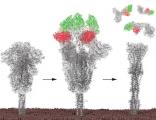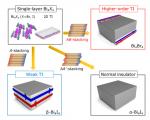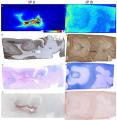Uranium contamination in our environment is a serious threat to public health. Successfully managing the problem to mitigate health impacts requires an understanding of how environments affect the different forms of uranium, the chemical reactions at work, and the molecular species that are created over time.
Approximately 1,700 scientists visit SSRL annually to conduct experiments in broad disciplines including life sciences, materials, environmental science, and accelerator physics. Science highlights featured here and in our monthly newsletter, Headlines, increase the visibility of user science as well as the important contribution of SSRL in facilitating basic and applied scientific research. Many of these scientific highlights have been included in reports to funding agencies and have been picked up by other media. Users are strongly encouraged to contact us when exciting results are about to be published. We can work with users and the SLAC Office of Communication to develop the story and to communicate user research findings to a much broader audience. Visit SSRL Publications for a list of the hundreds of SSRL-related scientific papers published annually. Contact us to add your most recent publications to this collection.
Made of a repeated structure of proteins and fats, myelin insulates our nerve cells, allowing signals to travel quickly and efficiently. If myelin is damaged, nervous system signals will not transmit as well. The degree of myelination could be an important diagnostic for brain health because it is disrupted in almost all known brain diseases. Yet current technologies to observe and measure myelin are inadequate for diagnostic applications.
The biosynthesis of methane is significant because this molecule is both a good source of energy and a greenhouse gas. Despite its importance, the processes by which methane is made is not well understood. Methane is synthesized by methanogens, archaea found in anaerobic conditions like bogs and the guts of mammals. Only these microbes are able to perform the tricky reaction of turning hydrogen gas and carbon dioxide into methane and water.
A potential treatment for COVID-19 patients is administering monoclonal antibodies, which can directly neutralize virus by interacting with its spike protein. Monoclonal antibodies are identified from patients or lab animals that have been exposed to the virus and manufactured in larger quantities to treat patients. One downside to monoclonal antibody treatment is the difficulty and expense in producing large quantities of these complex molecules. A pared-down alternative, a single-domain antibody called a nanobody, is easier and less expensive to produce. Nanobodies are also more stable and can potentially be administered through simple inhalation. A team of researchers are designing, characterizing, and improving nanobodies that are effective against the COVID-19 virus.
Spintronics is analogous to electronics, where an electron’s spin state is used to store information rather than, or in addition to, the charge. Potential uses for spintronics include storing information in electron spin, which is not disturbed by magnetic fields nor affects neighboring electrons like electron charge. Spintronics is considered one of the most promising emerging fields of research, having the potential to improve electronic devices’ speed, power use, and size. New materials are needed that are stable and achieve certain exotic quantum properties for spintronics to advance. A search for a suitable higher-order topological insulator (HOTI) is underway.
Evidence gathered over the last 40 years suggests that a diagnosis of multiple sclerosis (MS) includes different types of diseases, but MS is usually treated as one disease. MS is defined by a loss of myelin that surrounds the axons of neurons and inflammation, which leads to serious outcomes like paralysis, blindness, and bowel and bladder problems. Yet the causes and effective treatments of these symptoms may vary widely. Treatments that are developed to treat all MS patients have variable outcomes in individuals, and the underlying pathology of the disease also varies in different patients. Previous studies of MS lesions have revealed four distinct types (immunopatterns I, II, III and IV). Each pattern may respond better to a different treatment.
When trash is burned for energy, a residue called bottom ash (BA) is left behind. Each year the European Union alone creates millions of tons of BA, which can be used for construction after treatment. It is concerning that BA may contain metals like copper and zinc that leach into the environment, potentially harming wild life and, people. The amount of these metals in the ash does not indicate whether the material is a potential hazard since these metals are more or less able to mobilize into the surrounding environment depending on factors like pH and the solubility of their chemical form. To better understand which chemical forms of copper and zinc exist in bottom ash and if there is much variation between different ashes, a team of scientists from Sweden analyzed six samples from different waste-to-energy plants.
Switchable photovoltaic windows hold much promise as a new technology to mitigate greenhouse gases that cause climate change. These windows not only automatically and reversibly darken to decrease the need for air conditioning, they generate electricity. One promising active layer is based on metal halide perovskites (MHP), a crystalline material that can harness sunlight.
Nitrogen is an essential component for life and often a limiting factor for growth, despite the fact that air is composed of mostly nitrogen. The processing required to turn dinitrogen (N2) gas into a form usable by most living organisms is rare in nature. Breaking the triple bond of N2 requires the enzyme nitrogenase, which is found in some bacteria. The mechanism of nitrogenase, which uses metal ion containing cofactors to catalyze this energetically difficult reaction, is complex and difficult to decipher. A team of researchers has applied a new method to peek at the mechanism of the reaction by looking at the enzyme bound to its metal ion cofactors in an intermediate state.
The enzyme 3-Hydroxyanthranilate-3,4-dioxygenase (HAO) is critical for the metabolism of the amino acid tryptophan and the synthesis of the important coenzyme nicotinamide adenine dinucleotide (NAD+). Although the role of this enzyme has been long known, its mechanism and regulation have remained a mystery, because it is difficult to study. HAO creates the unstable product 2-amino-3-carboxymuconic semialdehyde (ACMS) that can self-cyclize into quinolinic acid (QUIN). Because excess amounts of QUIN have been implicated in neurologic diseases, HAO is a potential drug target. A group of scientists have determined the mechanism of the HAO enzyme by applying crystallographic techniques.














